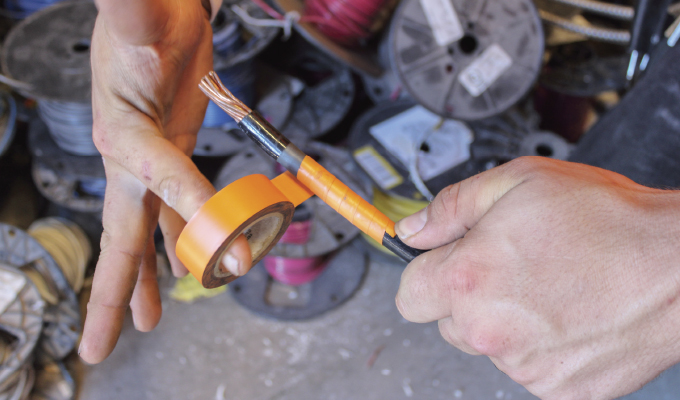Although it’s often concealed from view, pressure-sensitive adhesive tape is important to the building and construction industry. Tape is used in every segment of the building process, including HVAC, electrical, painting, and minor repairs. Here are the five types of tapes every contractor needs:
HVAC, HOUSEWRAP, AND INSULATION TAPE
HVAC, housewrap, and insulation tapes range from foil/film tapes to metal building insulation or mastic on rolls. HVAC tape is used to join and seal joints on rigid and flexible ductwork, while housewrap tape accomplishes the same function on housewrap, sheathing, insulation, and vapor barriers. Insulation tapes seal joints between pieces of pipe insulation or duct insulation.
The goal of these tapes is to provide a seal—often waterproof, airtight, and permanent—on a variety of materials. They may also be used to prevent air and moisture infiltration.
Because they are used on different materials, HVAC,
PAINT AND MASKING TAPE
Paint and masking tapes protect walls, floors, and other surfaces during painting, sanding, cleaning, or general construction activities. Colorful masking tapes can also be used for light bundling, color-coding or labeling.
Paint and masking tapes improve efficiency by protecting surfaces from paint and damage, helping to eliminate rework and costly touch-ups. These tapes are designed with varying levels of durability and adhesion, and may offer clean removability characteristics to prevent surface damage or adhesive residue left behind when the tape is removed. Durability allows them to withstand various environments and applications, such as indoor/outdoor use and heavy foot traffic when applied to a floor, while different degrees of adhesion allow them to be used on different substrates. For example, a low tack tape is best suited for delicate surfaces, such as freshly painted walls and faux finishes, while a medium adhesion tape can tackle harder-to-stick-to surfaces such as wood. Removability is a key characteristic when considering which tape to use: there are some formulations that do not offer clean removability, while others can remain on surfaces for 1 to 3 days, or a week or more, without damaging the underlying surface.
DUCT TAPE
Duct tape is built with a cloth backing coated with polyethylene to provide durability and waterproofing characteristics. Duct tape is manufactured with a wide variety of strength and adhesion properties, for light duty to extreme duty applications. It’s important to note that, despite its name, most duct tapes, unless designed for that specific purpose, should not be used to seal ductwork. General purpose duct tapes are not UL certified like HVAC tapes, and may flag or fail when exposed to extreme temperatures and other elements that are often present on HVAC jobsites.
General purpose duct tape is typically used for strapping or bundling at a jobsite, or to perform both temporary and permanent repairs. Specialty tapes are also available for specific applications such as adhering to stucco or hanging certain materials. The strength of its adhesive and backing, as well as its excellent environmental resistance, make it ideal for waterproofing applications. Duct tape can be found in a wide variety of colors, making it versatile for use on a range of surfaces. When choosing duct tape for a specific application, contractors should consider its strength characteristics, environmental durability, hand tearability, conformability, and the intended substrate or surface for application.
ELECTRICAL TAPE
Electrical tape is used to insulate electrical splices, as well as wire jacketing, or to bundle wire and cable. While most electrical tape used in building and construction is black, colored electrical tapes—sometimes called phasing tapes—are used to label wire voltage strength, phase, or function. Using the right color is critical in phasing tasks, as using the wrong color could indicate an inaccurate voltage quantity, putting technicians at risk.
Electrical tape is nearly always made of vinyl or a vinyl-based material such as PVC, which is popular because of its durability and tensile properties. An electrical tape’s dielectric strength—the maximum electric field strength the tape can withstand before breaking down—is of prime importance when selecting a product. Important characteristics and specs include UL listing, testing to electrical standards such as ASTM D1000, hand tearability, elongation, and durability.
SAFETY BARRICADE TAPE
Barricade tapes are non-adhesive and usually bear a written message to warn jobsite workers of the presence of wet paint, nearby high voltage wiring, or other hazards. Non-adhesive barricade tapes are used to block off dangerous areas, while adhesive floor marking tapes are applied directly to floors to mark hazardous areas. Floor marking tapes are available in a variety of solid colors and warning stripe patterns, each indicating a specific hazard or element that workers need to be aware of. Because of its role as a safety device, safety and barricade tapes can be subject to approval by the Occupational Safety and Health Administration (OSHA) in the United States.
Barricade tapes are often used outdoors, so they must have excellent moisture and humidity resistance and resist fading in relatively extreme environmental conditions. Other important characteristics include tensile strength, elongation, and clear readability of the printed warning message.
Learn more about choosing and using tape for professional results at www.TapeUniversity.com.
About the author:
Lisa Zierfuss serves as product manager for Building and Construction/HVAC tapes at Shurtape Technologies, LLC. In this role, she tackles the ongoing product development, project management and market research for the company’s pressure-sensitive tape solutions that serve the HVAC, remodeling and abatement, and general construction markets. For more information, visit www.shurtape.com.
Modern Contractor Solutions, December 2018
Did you enjoy this article?
Subscribe to the FREE Digital Edition of Modern Contractor Solutions magazine.



